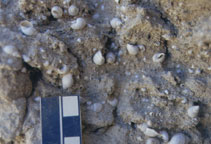 Because the rate of amino acid racemization is controlled by the temperature experienced by the fossil since burial (rather than when it was living), an evaluation of site temperature is required for geochronological interpretation. To minimize the effect of seasonal and diurnal temperature fluctuations, samples should remain buried at least 1 m and preferably 2 to 3 m throughout their post-depositional history. Surface collections from recently exposed sections, such as road cuts and river bluffs, are suitable.
Because the rate of amino acid racemization is controlled by the temperature experienced by the fossil since burial (rather than when it was living), an evaluation of site temperature is required for geochronological interpretation. To minimize the effect of seasonal and diurnal temperature fluctuations, samples should remain buried at least 1 m and preferably 2 to 3 m throughout their post-depositional history. Surface collections from recently exposed sections, such as road cuts and river bluffs, are suitable.
Each sample should comprise a collection of at least five monogeneric shells. For ion exchange analysis, the minimum sample size for each shell (or group of shells or shell fragments) is ~20 mg. For reverse phase, minimum sample size is <1 mg. An amino acid result for a single stratigraphic horizon is calculated as the average amino acid ratio of multiple shells that make up a sample collection. Shells that might comprise a mixed-age population are treated individually. Large shells can be sub-sampled in duplicate to assess intrashell variation.
